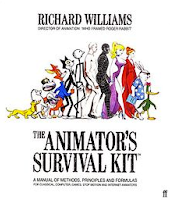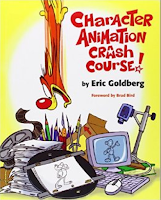Books may be kind of old school these days, but a good book is still a great place to start learning about and exploring the world of character animation.
We're also very selective; we won't make you buy a ton of books you won't have time to open, let alone read. So, what is on our animation reading list?
Animation Reading List - Our Top Picks
These are the two books which we think are pretty much essential for learning character and creature animation in Maya. Buy them, read them, consult them often, and you won't go far wrong.
 We recommend that any serious student of animation should buy a copy of The Animator's Survival Kit, by Richard Williams.
We recommend that any serious student of animation should buy a copy of The Animator's Survival Kit, by Richard Williams.The ASK is now the standard textbook for animators and easily the most comprehensive book available for learning animation.
You can also buy it as an eBook download, for use on your iPad. It's even better as an eBook since you can watch the videos as well, to illustrate the examples.
No 2: Animation Methods by David Rodriguez
Animation Methods is an excellent book on learning animation in Maya. It is a book that focuses primarily on 3D Character Animation, a step-by-step guide for learning Maya, and the Maya animation tools.
It also has useful sections on how to get into the industry, how to make a great demo reel, and how to get a job in animation. We think this is a very useful companion book to our course..
It is also an unusual book in that it makes extensive use of QR codes - meaning you can use your smartphone to scan the codes and then view a 3D animated clip of the lesson.
Animation Reading List - Other Recommended Books
These are the books we think you should browse and read. They are full of useful stuff. Buy them if you can afford them and have space on your shelf. If not, check them out from our library.
No 3: The Illusion of Life. The Illusion of Life was written by Disney animation legends Frank Thomas and Ollie Johnstone, and represents the accumulation of knowledge of the first "Golden Age" of Disney animation. It's a great read, though it's easy to get lost in the great stories about the early days of animation.
No 4: Cartoon Animation.
Cartoon Animation by Preston Blair was the first available book on animation, and has been in print since the early 1950s, regularly updated since then. Still full of very useful material.
No 5: Timing for Animation
by Harold Whittaker and John Halas is another very useful book on animation. It was first written some years ago but was recently updated and edited by former Animation Guild President Tom Sito.
No 6: Character Animation Crash Course.
 The Character Animation Crash Course by Eric Goldberg is an excellent resource by one of the most talented 2D animators in the world - the man behind the genie in Disney's Aladdin.
The Character Animation Crash Course by Eric Goldberg is an excellent resource by one of the most talented 2D animators in the world - the man behind the genie in Disney's Aladdin.No 7: The Complete Digital Animation Course.
The Complete Digital animation Course by Andy Wyatt is a very useful overall guide to all the processes involved in digital animation and film-making. Especially good for the technical bits that the older books don't cover.
OK - so you've bought a book or two, and checked a couple out of the library - what else? The next thing to do, assuming you have a laptop at home, is download a free copy of Autodesk Maya, and open it up. Maya is the main software we animate with, nowadays it's the industry standard. Below is a free tutorial in the Maya interface (there are tons of similar ones) hosted at YouTube.
Don't be daunted - just take a quick look! It does look a bit confusing at first but it's good to get familiar with the layout, and learn where the main hotkeys are, and how the interface works. You can register and get a free Maya student license here.
If you do some or all the things on this list - you will have a great head start with us in September 2016. We look forward to meeting you!
----Alex




No comments:
Post a Comment